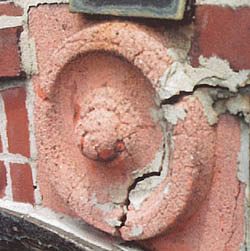 Unsafe facade conditions, such as cracked terra cotta, must be repaired immediately.
Unsafe facade conditions, such as cracked terra cotta, must be repaired immediately.
Between Feb. 21, 2005, and Feb. 21, 2007, owners of buildings more than six stories high—including co-ops and condominiums—must file detailed inspection reports describing the physical condition of their buildings' facades.
And while this marks the sixth time the reports are being filed, there is one significant difference: potential safety problems indicated in a building's previous filing must be eliminated before a new report is filed, or those problems will be classified as unsafe and must be repaired immediately. Violation of the law can result in a $1,000 fine, six months in jail and an additional fine of up to $250 a month until the violation is corrected.
No More Procrastination
"The facade law has allowed owners to procrastinate," said James G. Samson, a Manhattan lawyer who specializes in co-op and condo law. "But now, any owner or board that procrastinated is going to find itself in an emergency situation."
Mr. Samson explained that under the previous facade inspection law—Local Law 10 of 1980—if an engineer found a flaw in a facade that was otherwise sound, the condition merely had to be monitored to ensure it didn't get worse. A condition that remained stable could be carried over from one five-year inspection cycle to the next with the same status.
Many co-op and condo boards are unaware of earlier inspection reports for their building.
But in 1998, the city adopted a new facade law—Local Law 11. Under the new regulations, Mr. Samson said, such a condition, now designated as "safe with a repair and maintenance program," must be eliminated before the next scheduled inspection report is filed. (Conditions could include minor cracks, deteriorating mortar or water penetration.)
"Many co-op and condominium boards don't even know they have work to do," he said, explaining that since boards change, it would not be unusual for current board members to be unaware of earlier inspection reports. So, he said, any building that had items on the previous report that were listed as "safe with a repair and maintenance program" must now scramble to eliminate those items.
"And they're going to be in competition not only with others who procrastinated," he said, "but with owners who are ahead of the curve and who are going out for bids for work on the new cycle that's just starting."
Unprecedented Number of Repairs
Stephen Varone, president of Rand Engineering and Architecture in Manhattan, agreed. "There are an unprecedented number of repairs being done now," Mr. Varone said. "And there are still going to be a lot of reports held back."
He noted that owners and boards who have not addressed conditions on the last report have another decision to make. Do they get the work done immediately—before hiring an engineer to do the inspection for this cycle—or do they hold off on repairs, bring the engineer in now and get a report that includes both old and new information?
"The prudent thing would be to contact the engineer now, have him go over the previous report, find out what hasn't been done, and have him do this round's inspection," he said.
He noted that while the inspection may reveal new conditions that need to be addressed, the building owner will then have the option of addressing everything at the same time, or just repairing what must be repaired to file a new report minus the old items.
"This will be the last chance to go out to bid for work before we get into some really crazy competition," Mr. Varone said, explaining that since the law requires any condition considered unsafe to be addressed immediately, buildings that learn of such conditions will be competing for contractors with those who have less-urgent repairs. And that, he said, will raise prices.
Mr. Samson said the decision should be fairly simple. "Once you hang a scaffold over the side of your building," he said, "you fix everything within reach that needs fixing."
From The New York Times, January 16, 2005
